It is that time of the year that a major part of India turns to festivities and worship. Durga Puja is the annual autumnal celebration of worshipping the Divine Mother, Durga. The beauty of Goddess Durga is that she is worshipped in various avatars all across the country. The style of worship of Goddess Durga, therefore, varies from one state to another. In some states, it is piety and fasting. In other states, it is gaiety and feasting. West Bengal falls in the second category. And as declared in December 2021, Kolkata’s Durga Puja is now UNESCO Intangible Cultural Heritage.
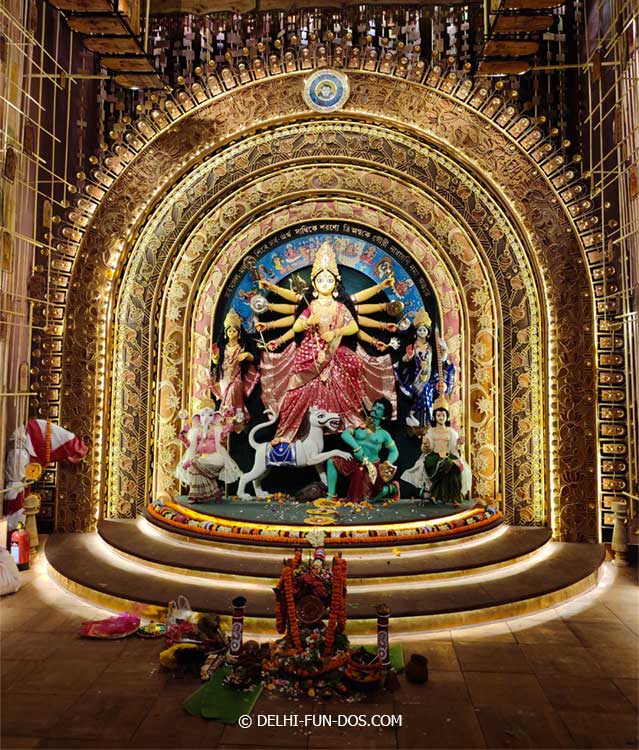
This is a matter of pride for everyone in India. There were already 13 Indian practices that were part of the UNESCO list. Some of the items were Chhau dance, Sanskrit theatre Kutiyattam, Ramlila, Kalbelia dance, Vedic chanting, Ramman theatre from Garwal Himalayas, Mudiyettu theatre from Kerala, Sankirtana from Manipur, Ladakh’s Buddhist chanting and Navroz. Durga Puja is the 14th entry.
The UNESCO list augurs hope that the Durga Puja, in its present form, would be propagated. Durga Puja already brings visitors from many parts of India and overseas to Kolkata. The UNESCO entree probably would bring the Durga Puja to a wider tourist circuit.
Why did Durga Puja in Kolkata get this coveted tag? Here is what you should know if you are in Kolkata during Durga Puja.
Contents
What to expect during Durga Puja in Kolkata?
Durga Puja in Kolkata, the capital of West Bengal is India’s response to the carnivals the world over. Durga Puja is a Hindu worship. Yet, the grand proportions of celebrations in Kolkata break religious boundaries and adopt a secular flavour. And it probably started like this.
History of Durga Puja in Kolkata
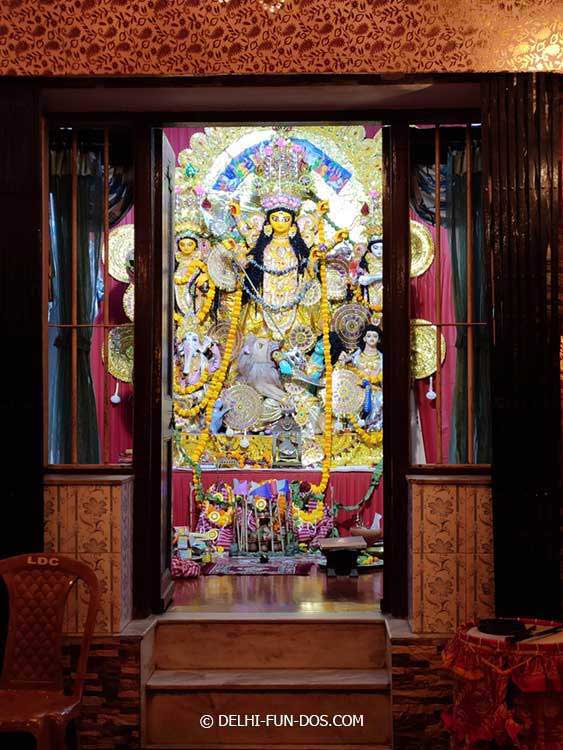
It is assumed that the first Durga Puja was held in the house of zamindar Sabarna Ray Chowdhury in the year 1610. To compete, many other zamindars (landowners) started celebrating Durga Puja in a grand manner. High-ranking British officers of the East India Company were invited to the festival. The arrangements would be even more elaborate to impress them. Grand parties with imported liquor and music and dance shows would be organised to entertain the guests. Given that non-Hindus were invited to the Puja, it is clear that from its inception, Durga Puja had a secular celebratory character.
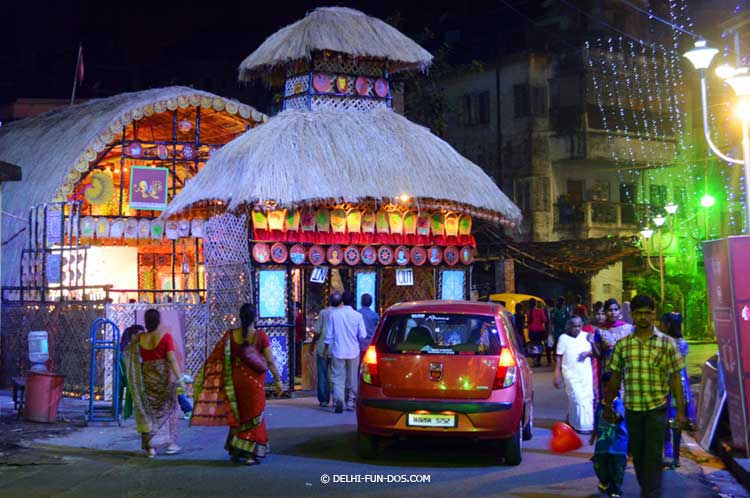
However, the common man felt left out from participating in this festival.
That led to the community Durga Puja or what is called the “Baroari” Puja. The word Barowari means – by 12 friends. Apparently, 12 friends from a locality pooled funds and organised the first Barowari Puja in 1909. Since then Durga Puja became a community festival where people of a neighbourhood would contribute and arrange their own Durga Puja.
Everyone irrespective of caste or religion was included in a Barowari or a community Puja. This trend caught on and Durga Puja in Kolkata now is a festival of the people.
Durga Puja pandals and idol
The whole city is covered with lights and crafty pandals or marquees are erected in various parks and neighbourhoods to install the Durga idol. Goddess Durga is typically worshipped along with the deities Lakshmi, Saraswati, Kartik, and Ganesh.
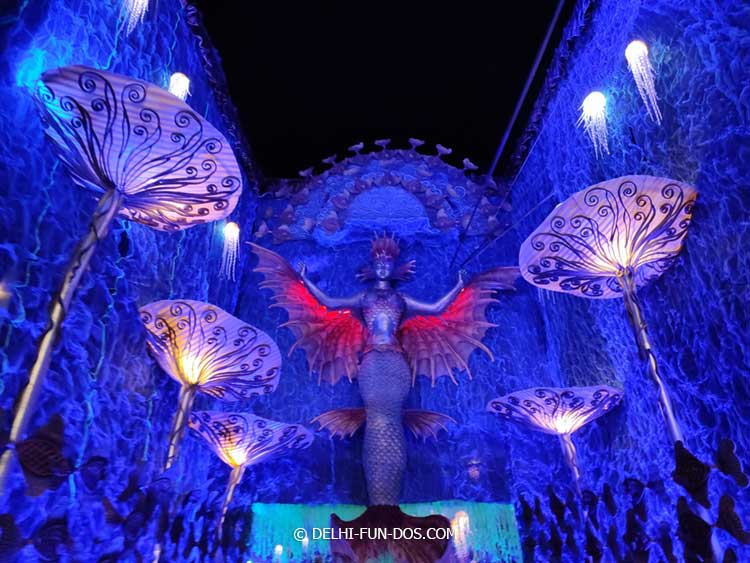
A Durga Puja Pandal in water world theme
The pandal does not necessarily resemble a temple. It could be a design talking about a social issue like the lack of living amenities in slums or something totally abstract like a dream. We also loved a pandal depicting the underwater world. Kolkata becomes a live art gallery in this period.
An idol in any community Puja typically ranges between 5 feet and 10 feet in height. It is mostly made of straw, rope, and bamboo structures layered with clay and finished with paint, clothes, and ornaments.
Sometimes art overrides tradition and then the deity is made of offbeat material that could range from paper to scrap. Many moons back, a Durga Puja gained notoriety for making the idol with sugarcane fibre. These days, fashion designers and jewellery brands have come forward to offer special clothing, sarees, and precious ornaments for idols.
Yes, it is also about commerce. In fact, crores of funds roll into the economy and percolate even to the grassroots level on the occasion of Durga Puja.
Durga Puja clothing
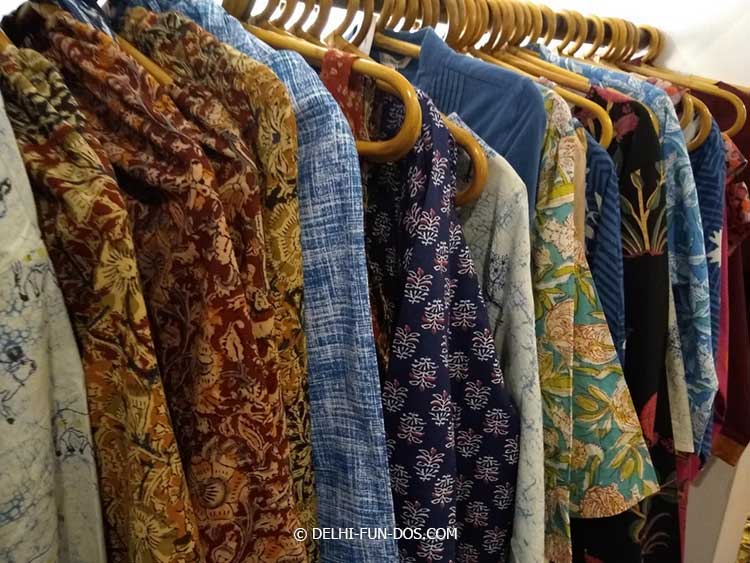
Only three kinds of gifts would work for Durga Puja. – 1. Clothes, 2. Clothes and 3. Clothes. Unlike Delhi, there is no concept of fancy gift boxes of juices, cookies, and chocolates being exchanged. Clothes or money for buying clothes are the only and default gifts for Pujo. This is because Bengalis traditionally wear new clothes, ornaments, and even new footwear on all days of Durga Puja.
That said, there is no fixed kind of attire for Durga Puja. People who are actively involved may wear saris and dhoti kurtas. Some people wear Indian clothes like kurta pyjamas while participating in the rituals. Again, there is no rule. You are free to wear just whatever you feel like during Durga Puja.
In any case, it is a time to dress up and everybody on the road is attired in their best.
Durga Puja food in Kolkata
There is nothing called Durga Puja food in Kolkata. The ritual food offering, commonly called Bhog comprises khichuri, payesh, fritters, luchi, suji halwa, sweets, mishti doi, and so on. The devotees share the blessed food after the rituals are completed.
Roadside food rules the roost in the afternoons and evenings. Chowmein, momo, biryani, Mughlai paratha, bhelpuri, phuchka (Gol Gappa), and egg & chicken rolls are hot favourites along with gallons of soft drinks and many cups of tea.
Big restaurants also bring out Puja special menu with special offers. This is a truncated version of their main menu focus being on popular fast food. Do be a little wary while eating out during Durga Puja. Sometimes, the food quality is not up to the mark.
Happy Durga Puja??
No, they don’t say that in Kolkata very often. It’s not like how it is in Delhi when you say Happy Diwali to everyone during the festival. Even Happy Pujo won’t cut it.
You say nothing during Pujo, just go out with buddies and watch in awe, all these beautiful pandals. Post-Dussehra or Vijayadashami, the classical greeting here is “Shubho Bijoya”.
Also Read: A Delhiite’s First Impression of Kolkata
What to do during Durga Puja in Kolkata?
The festival lasts for 5 days. People turn out on the streets in colourful clothes and the city is awake all 5 day and night. The celebrations reach carnival proportions and Public transport runs 24 X 7 from Shashthi to Dashami. We were surprised that 4 o’clock in the morning felt like 7 Saturday evening.
Visit Awe Inspiring Durga Puja Pandals Of Kolkata

A beautiful Durga Puja Pandal made of stained glass art
You can hop from one pandal to another viewing the artistic creations. You can walk, drive (not recommended), or take the metro or the buses or hire cabs or take the classic Kolkata yellow taxi.
You can stop for refreshments at the thousands of makeshift food and beverage stalls that pop up at this time. If you want to avoid the crowd, you can sit at a cafe and a restaurant and absorb the festivities around you.
Anjali
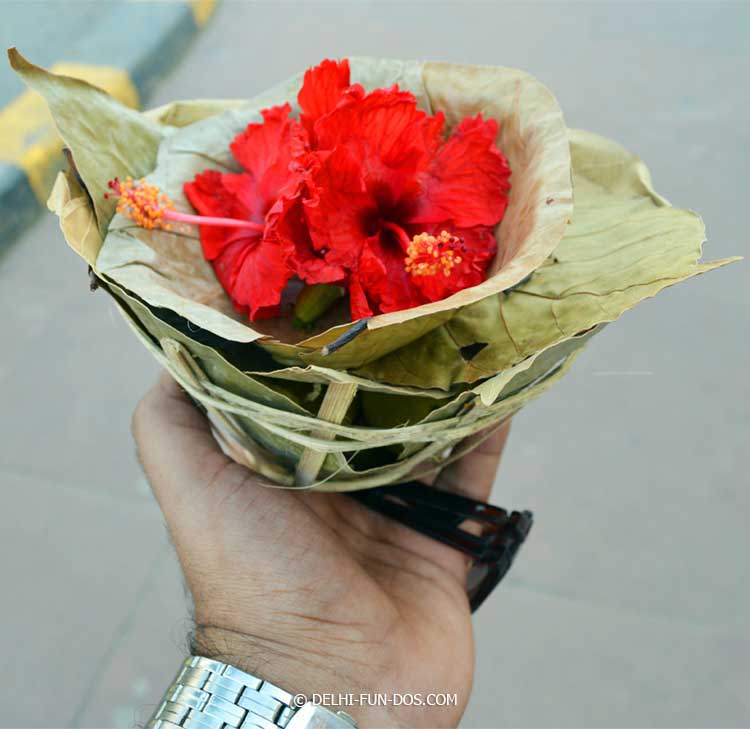
If you are the religious sort, or you want to add divinity to your celebration, you can often Anjali at any temple or any of the Durga Puja pandals.
Anjali is offering flowers to the Goddess while repeating mantras that the priest chants. This is mostly a day-time activity and a devotee is supposed to fast till Anajli is over. Candid confession, we have often been slack about that. After all, why would the Goddess, our Divine Mother, want us to starve for her?
Community feasts during Durga Puja
Many neighbourhoods have community lunches on Durga Puja days. Try to attend one of those. It could be vegetarian or non-vegetarian meals. Mind you, this is not the prasad. This is just a simple lunch that is transformed into something special just because people are having it together.
Dhunuchi Naach for Goddess Durga
A dhunuchi is a clay vessel used to burn coconut husk and dhuno or Indian frankincense. During Durga Puja, some devotees would dance to dhak drum beats holding a burning dhunuchi emitting smoke and a lovely fragrance of burning frankincense. The dhunuchi dancers would often go into a trance. The combination of the earthy smoke emitting from coconut and frankincense, the dhak drum beats, and the excited bystanders creates a heady combination.
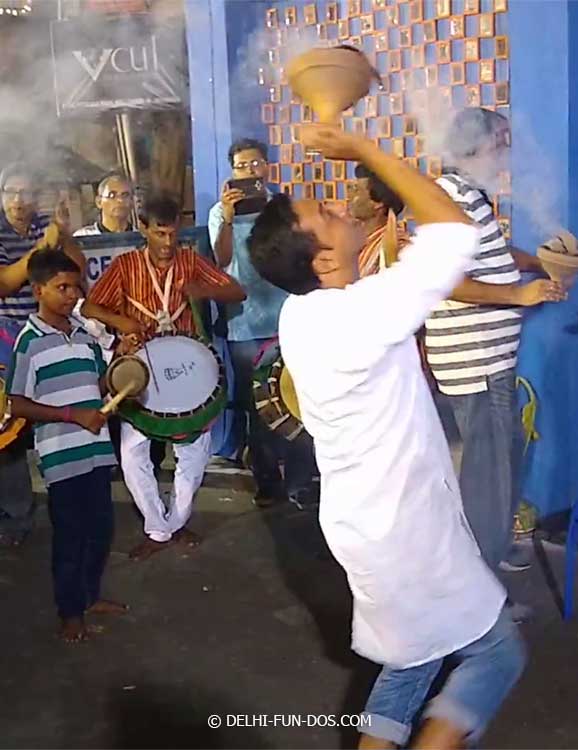
If you are at any Durga Puja site, you can see the dhunuchi dance being performed in the evening. Some places hold competitions too. This dance was earlier a male bastion that has been broken down by women. Women also often participate in the rather daring dhunuchi dance which is even more complex while manoeuvring the pleats of the sari.
You can watch on the side or join as well if you are confident. It is a free-for-all activity.
Sindur Khela
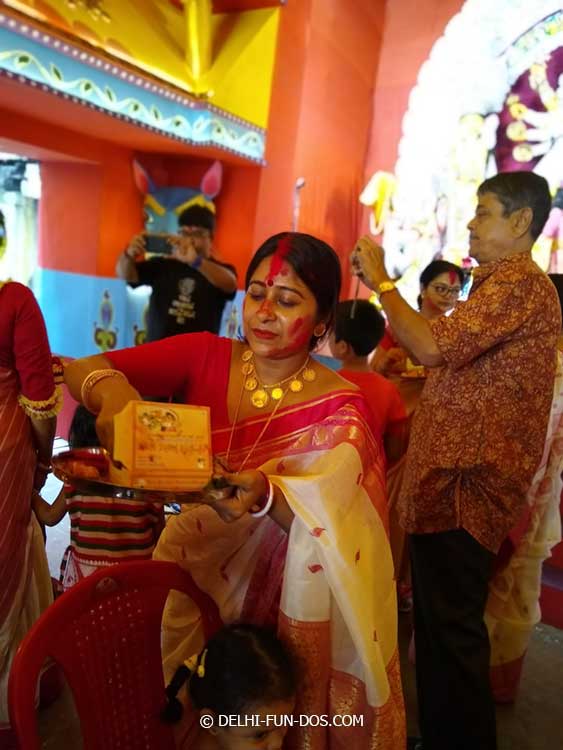
Traditionally Goddess Durga is bid adieu by smearing sindur or vermillion on the idol’s forehead. Married women then greet each other applying sindoor on each other’s hair parting and wishing long life for their husbands. This activity is more of a colour-smearing festival now. Like Holi people try to paint each other with the red sindoor.
Some people argue that this is a gender-biased activity. Others feel that this activity leaves out widows and hence is not inclusive. Gender activists argue that this excludes the LGBTQ community.
All that is indeed debatable. However, it is a fun activity and people break into a jig by way of celebrating. This happens at all Puja sites on Dashami, the last day of Durga Puja. In recent times. some communities have broken the shackles. Anybody or everybody notwithstanding their marital status or gender preference is welcome to participate in their indoor khela.
Leave your inhibitions and get coloured by activity. Or, stand on the side and take the most colourful photos and videos you can imagine.
PIN IT
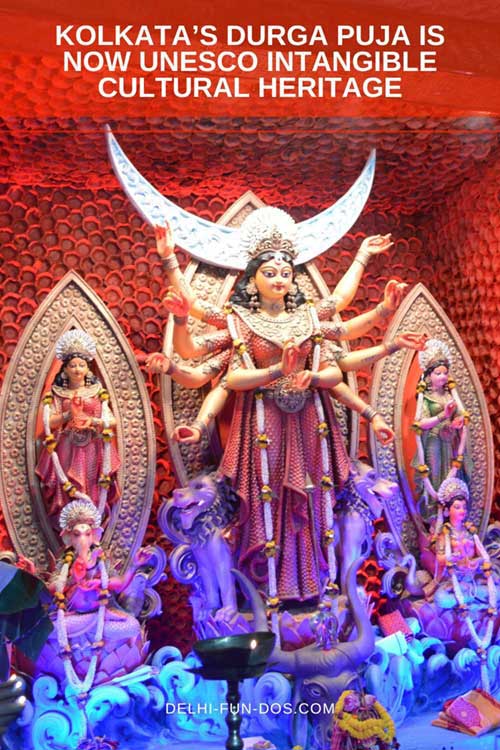
Visarjan
Visarjan is the return ritual of the Goddess to her home on the Mountain Kailash. This process involves carrying the idols to the banks of the River Ganga or a convenient waterbody amidst drums, dance, and fanfare. The Goddess is given a grand farewell on way to the river bank and then the statues are immersed in the water with an invite for the next year – Punaragamanay Cha (do come again).
This is a ritual when people are happy and sad at the same time. Yet when the idols are taken to the riverside and immersed, it is a moment of goosebumps. If you know anyone who is involved in any Durga Puja, try to get yourself invited for the visarjan journey.
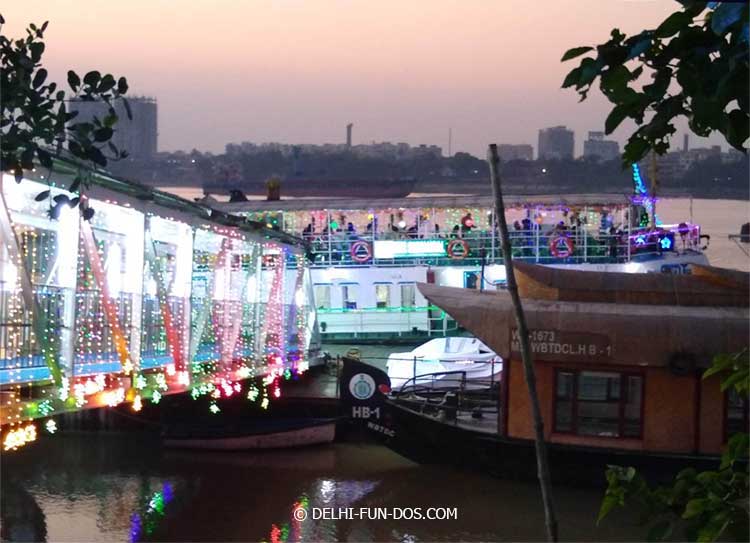
Ferry ride to watch Visarjan in Kolkata
The West Bengal government also organises ferry rides for viewing visarjan. Refreshments are served during the 2 to 3 hours long rides. Sitting on the open deck, you get to see many heritage ghats built on Ganga, some more than 200 years old. The idols are queued up and dropped one by one. This evening activity is very refreshing and the charges are nominal.
Watch Cultural Performances
There are fairs and exhibitions, theatres, and cultural programs arranged in almost every neighborhood. You can catch a song here and jive to a dance at the next. Bedabrata boasts that he was a regular at his neighborhood Durga Puja plays. You can watch some local talent at such rehearsed or impromptu dos. Any lack of skill is compensated by the enthusiasm of the participants.
It is actually amazing how flexible Durga Puja is in terms of celebration. One may not be a believer but that doesn’t deter one from dressing up, attending get-togethers with friends and families, watching performances, eating out, and generally making merry.
These activities are as inherent to Durga Puja as are the rituals.
Durga Puja is now a UNESCO Intangible Cultural Heritage – The impact
It is exactly this spirit of the celebration of Durga Puja that has struck a chord with UNESCO.
As per UNESCO, “Intangible cultural heritage is the practices, expressions, knowledge and skills that communities, groups and sometimes individuals recognise as part of their cultural heritage. Also called living cultural heritage, it is usually expressed in one of the following forms: oral traditions; performing arts; social practices, rituals and festive events; knowledge and practices concerning nature and the universe; and traditional craftsmanship.”
Durga Puja in Kolkata is a combination of all the above elements.
The unique marquees and idols are often made out of traditional art forms from all over India.
The pandals are often designed to reflect craft form from Bengal or any other part of India. Lippan art from Gujarat, metalwork from Bastar, woodwork from Gujarat, and Kathputli from Rajasthan are among the endless forms of pandals that we have seen.
The classical clay idol is typically made at Kumortuli in Kolkata. However, modern versions of the idol are made at artists’ or sculptors’ workshops.
In addition to promoting the crafts, the various performances during Durga Puja also serve the cause of forwarding these art forms. The diversity of the Durga Puja festival makes it a celebration without any boundaries. Everybody is welcome to the grand occasion.
UNESCO’s recognition is therefore a nod to the inclusive nature of Durga Puja in Kolkata. Mere words are not enough, you must witness it for yourself to soak in the fervour.

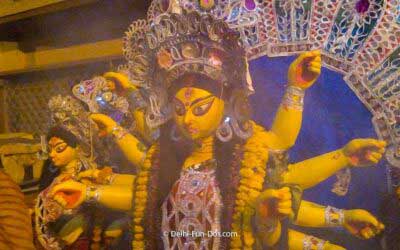

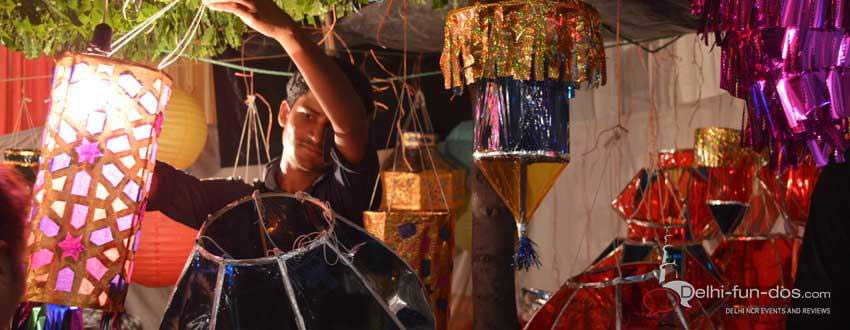
Wow! Everything looks so extravagant and colorful. I’m sure it’s a vibe from that alone!
The vibe rocks in an Indian way.
What a neat thing to be acknowledged by UNESCO! This would be wonderful to experience and I enjoyed learning about it.
Yes, it is a happy feat
I’ve never heard of this celebration before. It’s interesting that it’s celebrated in such different ways based on where you are. It would be neat to see all the festivities in another country. I’m sure it’s so different than what we do here.
It is very different from festivals in the west or any festival of Asia
I have never been to India before, but this is sure very interesting. Maybe one day I will plan a vacation there. Those clothes look amazing!
If you want to witness this festival, you should look up Durga Puja dates that year.
It can be so lovely to visit during one of the celebrations. You can really get a feel for the people and join in the celebrations. This would be lovely to see.
It’s absolutely incredible and very beautiful! No wonder it’s now part of the UNESCO intangible cultural heritages!
Incredible is the word!
This is such an interesting festival. I think the feast would be my favorite part.
Yes, most enjoyable.
I love Bengali culture. Amazed to see the beautiful pictures here.
One of is Bengali 🙂